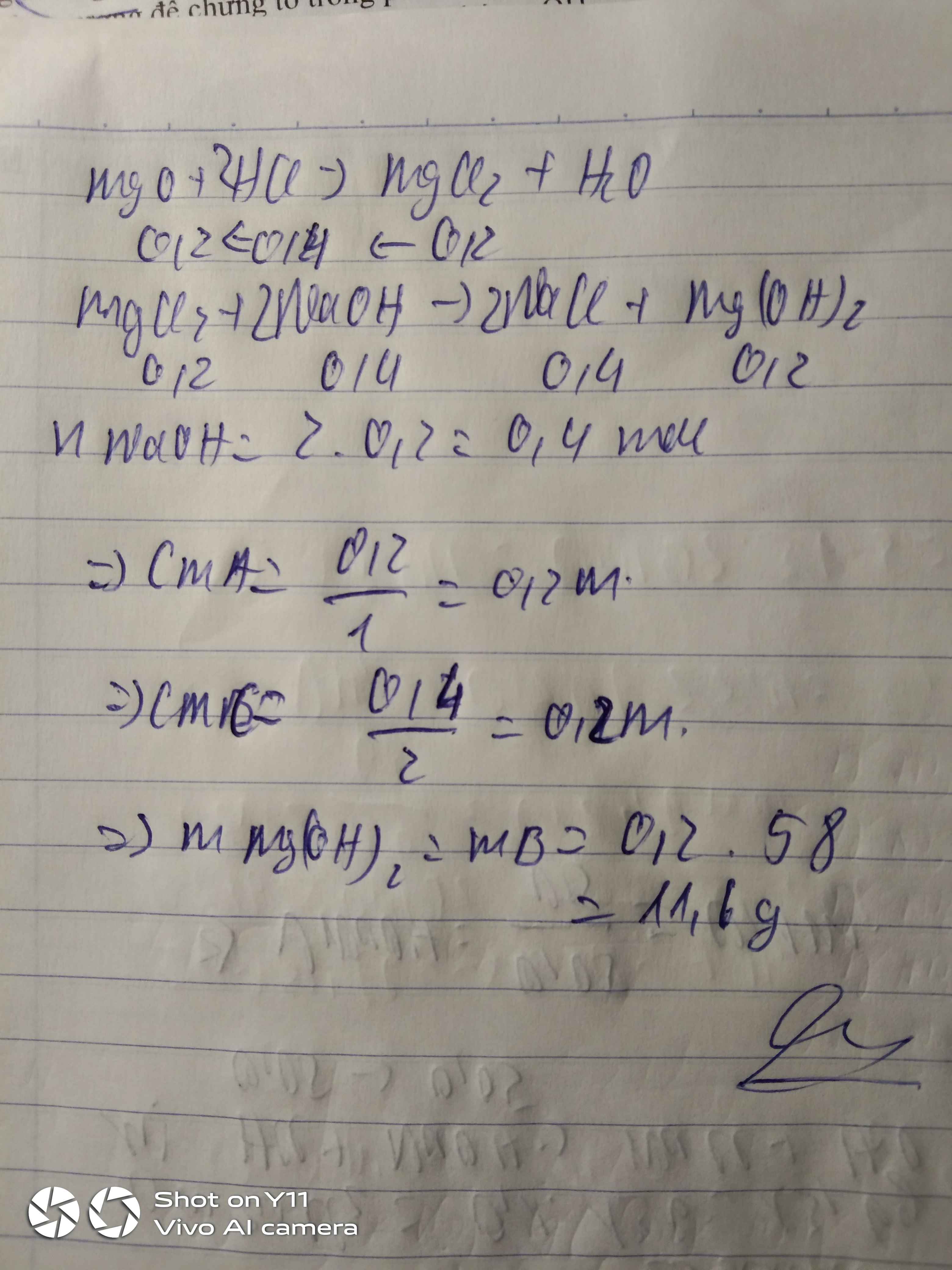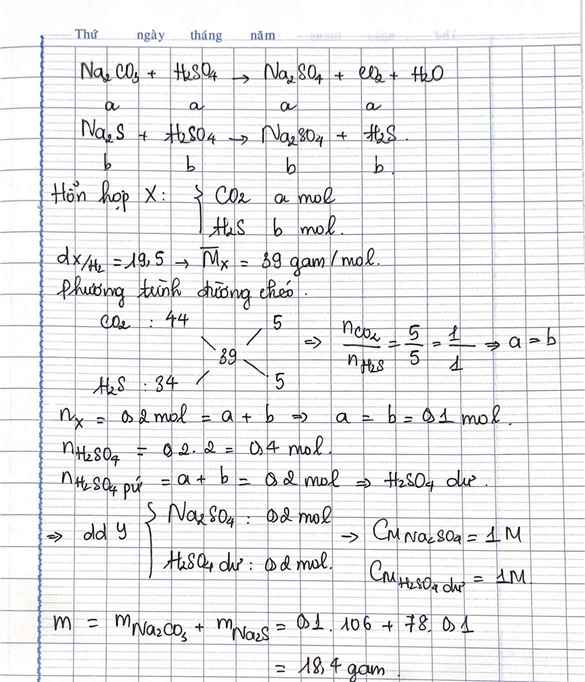Hãy nhập câu hỏi của bạn vào đây, nếu là tài khoản VIP, bạn sẽ được ưu tiên trả lời.

a, \(n_{Fe}=\dfrac{8,4}{56}=0,15\left(mol\right)\)
\(n_{HCl}=0,2.2=0,4\left(mol\right)\)
PT: \(Fe+2HCl\rightarrow FeCl_2+H_2\)
Xét tỉ lệ: \(\dfrac{0,15}{1}< \dfrac{0,4}{2}\), ta được HCl dư.
Theo PT: \(n_{H_2}=n_{Fe}=0,15\left(mol\right)\Rightarrow V_{H_2}=0,15.22,4=3,36\left(l\right)=3360\left(ml\right)\)
b, Theo PT: \(\left\{{}\begin{matrix}n_{FeCl_2}=n_{Fe}=0,15\left(mol\right)\\n_{HCl\left(pư\right)}=2n_{Fe}=0,3\left(mol\right)\end{matrix}\right.\)
\(\Rightarrow n_{HCl\left(dư\right)}=0,4-0,3=0,1\left(mol\right)\)
\(\Rightarrow\left\{{}\begin{matrix}C_{M_{FeCl_2}}=\dfrac{0,15}{0,2}=0,75\left(M\right)\\C_{M_{HCl\left(dư\right)}}=\dfrac{0,1}{0,2}=0,5\left(M\right)\end{matrix}\right.\)
c, Ta có: \(m_{ddHCl}=1,25.200=250\left(g\right)\)
⇒ m dd sau pư = 8,4 + 250 - 0,15.2 = 258,1 (g)
\(\Rightarrow\left\{{}\begin{matrix}C\%_{FeCl_2}=\dfrac{0,15.127}{258,1}.100\%\approx7,38\%\\C\%_{HCl\left(dư\right)}=\dfrac{0,1.36,5}{258.1}.100\%\approx1,41\%\end{matrix}\right.\)

\(n_{Mg}=\dfrac{4,8}{24}=0,2\left(mol\right)\)
\(Mg+2HCl\rightarrow MgCl_2+H_2\)
0,2-->0,4----->0,2------->0,2
a
\(V_{H_2}=0,2.22,4=4,48\left(l\right)\)
b
\(CM_{MgCl_2}=\dfrac{0,2}{0,2}=1M\)
c
\(MgCl_2+2NaOH\rightarrow Mg\left(OH\right)_2+2NaCl\)
0,2------>0,4
\(V_{dd.NaOH}=\dfrac{0,4}{2}=0,2\left(l\right)\)

a)
$K_2SO_4 + BaCl_2 \to BaSO_4 + 2KCl$
b)
$n_{K_2SO_4} = 0,2.2 = 0,4(mol)$
$n_{BaCl_2} = 0,3.1 = 0,3(mol)$
Ta thấy :
$n_{K_2SO_4} : 1 > n_{BaCl_2} : 1$ nên $K_2SO_4$ dư
$n_{BaSO_4} = n_{BaCl_2} = 0,3(mol)$
$m_{BaSO_4} = 0,3.233 = 69,9(gam)$
c) $n_{K_2SO_4} = 0,4 - 0,3 = 0,1(mol)$
$V_{dd\ sau\ pư} = 0,2 + 0,3 = 0,5(lít)$
$C_{M_{K_2SO_4} } = \dfrac{0,1}{0,5} = 0,2M$
$C_{M_{KCl}} = \dfrac{0,6}{0,5} = 1,2M$

a/ Gọi nồng độ mol của HNO3;HCl lần lượt là 2a, a (mol/l)
Khi đó: nHNO3=0,4a; nHCl=0,2a mol
=> nH+ = 0,6a mol
nNaOH=0,1 mol, nBa(OH)2=0,2.0,05=0,01 mol
H+ + OH- ------> H2O
Theo PT ta được: \(n_{H^+}=n_{OH^-}=0,1+0,01.2=0,6a\)
=>a= 0,2M
Vậy nồng độ mol của HNO3;HCl lần lượt là: 0,4; 0,2 (M)
b/ nH+ =0,5.0,2.2+0,5.0,2=0,3 mol
+) Dung dịch B gồm: nNaOH=0,1 mol; nBa(OH)2=0,05 mol
=> n OH- = 0,1+ 0,05.2 = 0,2 (mol)
PTHH: H+ + OH- ------> H2O
Theo PT: nH+ = n OH- =0,2 mol<0,3 mol
Vậy dung dịch C còn dư axit ⇒ có tính axit.
c/ Gọi thể tích dung dịch B cần cho để tạo được dung dịch D trung hòa là: V (l)
Ta có: nH+ = n OH-
⇒0,3=1.V+0,5.2.V
⇔V=0,15
⇒ Lượng dung dịch B cần thêm là: Vthêm=0,15−0,1=0,05(l)

a.CuCl2 + 2NaOH -> Cu(OH)2 + 2NaCl
0.15 0.3 0.15 0.3
Cu(OH)2 -> CuO + H2O
0.15 0.15
nNaOH = 0.3 mol
\(CM_{CuCl2}=\dfrac{0.15}{2}=0.075M\)
b.Vdd sau phản ứng = 0.2 + 0.15 = 0.35l
\(CM_{NaCl}=\dfrac{0.3}{0.35}=0.86M\)
c.mCuO = \(0.15\times80=12g\)

